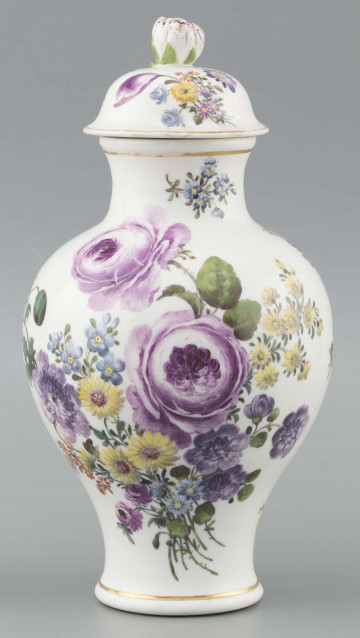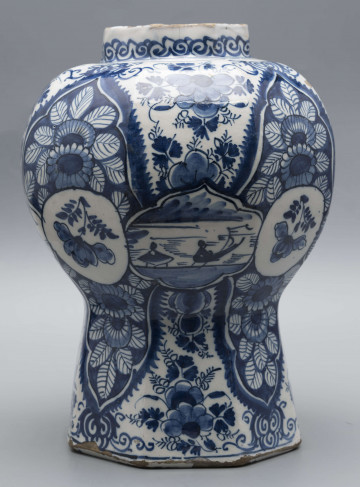
Vase with lid
1860 — 1780
National Museum in Lublin
Part of the collection: Faience, ceramic and metal vessels and items (late 17th–early 20th c.)
In the 17th century the level of wealth of the Dutch society increased and thus the need to surround oneself with valuable and beautiful objects arose. Ceramic workshops produced so-called sets consisting of an odd number of vessels - three, five, seven - of different shapes but identical decoration. They were placed symmetrically on the cornices of doors, closets and fireplaces to enliven the interiors with their richness of shapes and painted patterns. The presented vase originally belonged to such a set. It was made in the most famous Dutch ceramics production centre at the time when Europe was dominated by the fashion for Chinese porcelain. In the 16th century, emigrants from Italy brought the art of majolica production to the Netherlands - noble ceramics covered with white glaze and colourfully painted. In 1615 a grand auction was held in Delft where local craftsmen could buy, or at least admire, various examples of Chinese porcelain. These sources of inspiration influenced the development of their own production with individual character, richness of forms and decoration and high technical level. Interestingly, the visual similarity to Chinese imports meant that the white-glazed, painted faience was referred to in the Netherlands as china (porcelain).
The vase was made in De Drie Porceleyne Flessies (Three Porcelain Bottles) factory, founded in Delft in 1661. Its creator was Willem Jacobusz van der Kool, who took over the factory from his father in 1702 and ran it together with his wife, Anna Maria, née Schrevelius. His wife inherited the factory in 1717 and continued to run it independently until 1745, producing a wide range of objects with designs inspired by oriental art. Despite high competition, the factory found a market for its products not only in the country, but also on the international market, which is the best evidence of their quality.
Barbara Czajkowska
Author / creator
Dimensions
cały obiekt: width: 36 cm
Object type
dish
Technique
decorating ceramic by painting
Material
faience
Creation time / dating
Creation / finding place
Owner
The National Museum in Lublin
Identification number
Location / status

1860 — 1780
National Museum in Lublin

1740 — 1750
National Museum in Lublin

1840 — 1847
National Museum in Lublin
DISCOVER this TOPIC
Museum of King Jan III's Palace at Wilanów
DISCOVER this PATH
Educational path